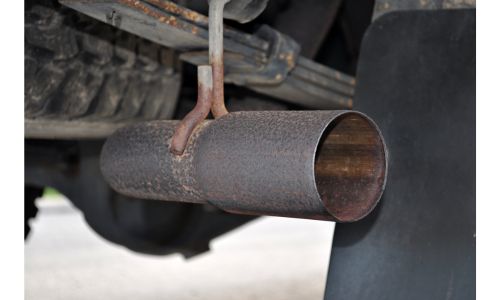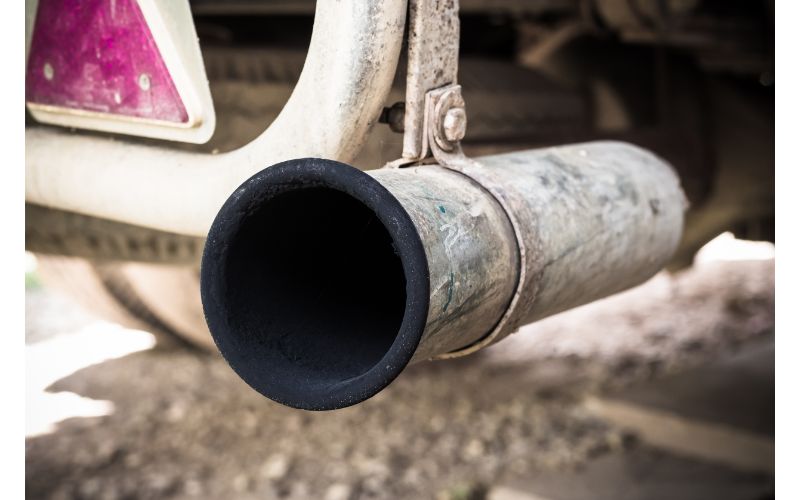Straight-piping is a popular way to customize trucks to produce loud, rumbling exhaust sounds. This modification eliminates catalytic converters and mufflers from the exhaust system and replaces them with plain pipes. Now, wondering how to straight pipe a truck? Well, start by parking and raising the truck to access the underside. Remove the exhaust system, determine the required straight pipe length, and cut it accordingly.
Finally, use a band clamp or U-bolt to connect the straight pipe to the exhaust manifold before securing it with clamps. Keep reading to learn how to straight-pipe your truck, the necessary tools, the pros and cons, and tips for the best results.
Necessary Materials And Tools
Before you straight-pipe your truck, you’ll have to gather the following materials:
- High-quality pipes
- Exhaust hangers
- Pipe clamps
- Exhaust tips
You’ll also need to get some tools, such as;
- Safety goggles
- Work gloves
- Angle grinder
- Measuring tape
- Jack and Jack stand
- Wrenches
- Rubber mallet
How To Straight Pipe A Truck – Step-By-Step Guide
Before you straight-pipe your truck, you need to understand its exhaust system.
- Gather information about what size its components are and how they’re configured.
- Most importantly, find the best options for straight-piping your truck model. The information you learn about the exhaust system, such as its exhaust diameter, will help you get the appropriate straight pipe for your truck.
- Once you have the straight pipe and all the tools and materials listed above, it’s time to get to work.
Depending on personal preference, you can straight-pipe your truck with or without welding.

Part One: How to straight-pipe a truck without welding
If you want to straight-pipe your truck without welding any parts, here’s a step-by-step guide:
Step 1: Park the car and raise it
First, park your truck on level ground and raise it. You can use the jack stands or a car lift to raise the truck.
Step 2: Take out the exhaust system
After raising your truck, remove the exhaust system. Here’s how to do that:
- Find the oxygen sensors and disconnect them.
- Apply penetrating fluid to all the nuts in the exhaust system so they’re easy to unscrew.
- Unscrew the nuts to release the pipes.
- Use a wrench to loosen the clamps connecting components like the manifold and muffler.
- Find the rubber hangers that support the exhaust system and remove them.
- Carefully take out the exhaust system.
Step 3: Cut the straight pipe to size
Use the measuring tape to determine what length of straight pipe fits your truck. Mark that length on the pipe and cut it using the angle grinder.
Step 4: Install the straight pipe
- Connect the straight pipe to your vehicle’s exhaust manifold and secure it with a band clamp or a U-bolt.
- You can also use a flex pipe to connect the straight pipe if it has to go through a bend.
- Finally, use clamps and exhaust hangers to secure the straight pipe to the vehicle’s underside.
- With the straight pipe in place, you can add the exhaust tips to give your truck’s exhaust a unique sound.
Part two: How to straight-pipe a truck by welding
If you’re comfortable with welding, here’s how to install a straight pipe on your truck:
- Start by parking the car, raising it with jack stands, or hoisting it.
- Take the exhaust system out.
- Create a plan for how the pipes will be laid out and account for any bends in the layout.
- Measure and cut the pipes according to your planned layout.
- Weld the pipes together with a welder.
- Connect the welded straight pipe to the truck’s exhaust manifold and secure it with a band clamp or U-bolt.
- Finally, secure the straight pipe to the truck’s underside with the appropriate exhaust hangers.
- You may also install exhaust tips to your straight pipe to enhance the sounds the exhaust makes.
Here’s a video showing how to straight-pipe a car
Four Precautions To Take When Straight-Piping A Truck
If you’re considering straight piping your truck, here are some precautions you can take to ensure the process is safe. It doesn’t impact engine performance:
1. Research the local regulations
Before you straight pipe your truck, it’s important to research your area’s laws regarding exhaust modification. Straight-piping is illegal in many jurisdictions because laws aim to curb noise pollution and high emissions.
2. Exhaust routing
When planning your new exhaust route, keep it away from electrical wires and sensitive components like brake and fuel lines to prevent potential issues.
3. Safety
Ensure you wear protective gear like goggles and gloves to protect yourself.
4. Consult with technicians
Seek advice from experienced automotive professionals about how best to straight-pipe your truck and the potential consequences.
Tips For The Best Results When Straight-Piping Your Truck
Here are some tips that will help you get the best results when you straight-pipe your truck:
- Select the correct pipe size
It’s important to ensure you get the appropriate pipe size for your truck to avoid performance issues and poor exhaust flow. Wrong exhaust pipe size causes back pressure issues, negatively impacting engine performance due to poor exhaust gas flow.
- Use high-quality materials
Use the best materials, components, and pipes that you can find to ensure the system is durable and doesn’t leak.
- Proper welding
It’s important to use proper welding techniques to ensure the new exhaust system has structural integrity. A properly welded straight pipe is much more durable than a poorly welded one.
- Tune your car
Depending on the model, you may have to tune your truck to optimize engine performance. Re-tuning will enable the engine to take maximum advantage of the straight pipe exhaust and prevent any negative effects.
What Are The Pros And Cons Of Straight-Piping A Truck?
Installing a straight pipe exhaust has advantages and disadvantages.
Advantages of straight-piping
- Better performance
Straight-piping often includes the removal of the catalytic converter, meaning the backpressure on the engine is reduced significantly. This pressure reduction boosts performance by allowing the by-products of combustion to leave the engine cylinders more rapidly.
- Sound
Trucks with straight-pipe exhausts make louder sounds because they don’t have exhaust mufflers. Most vehicle enthusiasts love these rumbling roars because they make the truck sound powerful.
- Gas economy
A straight-pipe exhaust is lighter than a regular exhaust. Combining the fact that the truck weighs less with improved engine performance gives you better fuel economy.
Disadvantages of straight piping
- Noise pollution
Trucks with straight pipe systems make a lot of noise, which may be considered noise pollution in some localities.
- Emissions
Straight pipe exhausts don’t have catalytic converters to clean their emissions. As a result, trucks with these systems release harmful gasses like carbon monoxide and nitrogen oxides into the air.
- Illegality
Straight-pipe exhausts are illegal in many states because they cause noise pollution and emit harmful gasses into the air. As a result, you may be unable to drive your truck freely wherever you wish.
Frequently Asked Questions
Here are some answers to common questions about straight piping a truck.
Q: Can I afford to straight-pipe my truck?
On average, a new straight-pipe kit costs between $400 and $600. If you decide to engage the services of a professional, you’ll have to pay an hourly rate of $100 for labor. Hence, straight-piping a truck will cost between $500 and $1,000 for everything, including labor, depending on the type and model.
Q: Will a straight pipe exhaust damage my truck’s engine?
No, straight piping your truck will not damage the engine. Rather, it will make your truck lighter, increase engine performance, and improve fuel economy.
Q: Will straight-piping void my truck’s warranty?
No. Straight-piping your truck should not void your warranty. However, if the exhaust system was originally part of the warranty, it will no longer be covered after you straight-pipe it.
Conclusion
In summary, to straight-pipe your truck, you must hoist it, remove the current exhaust, connect the straight pipe to the exhaust manifold, and secure it with clamps. This modification improves engine performance and fuel economy but also causes noise pollution and releases harmful emissions.
Before installing a straight-pipe exhaust, find out whether you’re legally allowed to do so in your state. Also, ensure you get the correct pipe size and weld the joints properly to avoid leaks. Don’t forget to wear protective gear, especially if you’re doing all the work alone.

